Intel Alder Lake-H Core i9-12900HK Review: MSI's Raider GE76 Goes Hybrid
by Brett Howse on January 25, 2022 9:00 AM EST- Posted in
- CPUs
- Intel
- MSI
- Laptops
- Alder Lake
- GE76 Raider
- 12th Gen Core
- Alder Lake-H
System Performance: Hybrid CPU Design
With the new hybrid CPU design available in Alder Lake there are now 20 threads available. The system features six P-Core, and each P-Core offers simultaneous multithreading with two threads per core, meaning there are twelve threads available on the P-Cores. The E-Cores are single-threaded only, and there are eight E-Cores. The new Thread Director from Intel coupled with Windows 11’s thread scheduler is aware of the cores being high-performance and low-performance and will tend to assign work accordingly; but if the system is not busy and the workload is in the foreground and multi-threaded, it will schedule threads across all 20 cores if needed. If an active task is moved to the background by the user, by either minimizing the task or opening another workload, the background task is allocated to the E-Cores and the P-Cores are prioritized for user-focused work.
This means that even on a heavily loaded system, system responsiveness should be maintained, and although the user will not have their full system performance available, the P-Cores will be prioritized for active workloads instead of background tasks. For our standard performance testing, benchmarks are always run as the only active task so that the results are representative, but for this review we will also cover some multi-tasking scenarios in a bit.
To test system performance, the system was set to dedicated graphics mode since this is the way most Desktop Replacement systems will be run, and the MSI laptop was set to its maximum performance setting.
PCMark 10

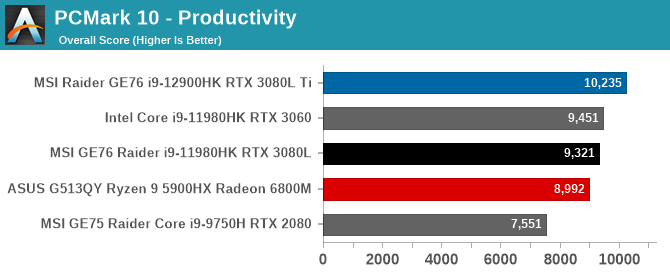
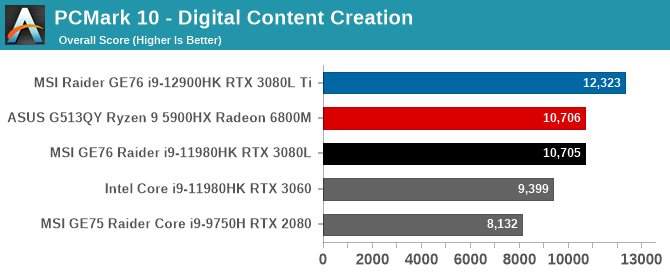
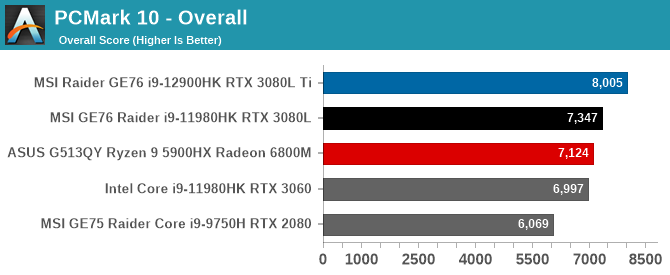
UL’s PCMark is a full-system benchmark which not only measures CPU performance, but also memory, storage, and graphics. It is being included as a reference since we always include it in laptop reviews, but be aware that the MSI Raider GE76 now offers the RTX 3080L Ti GPU, which is a step above the RTX 3080L found in the 2021 MSI GE76 Raider. As with all laptop testing, it is almost impossible to have a completely apples to apples comparison. The Raider GE76 also ships with much faster DDR5-4800 memory, an advantage of the Alder Lake platform.
That being said, the new Alder Lake system is by far the quickest notebook we have ever tested on PCMark 10. Some of that is CPU, and some is GPU, and some is memory, and some is storage. As was said at the start, Intel is putting their best foot forward, and it is hard to blame them.
Cinebench R20
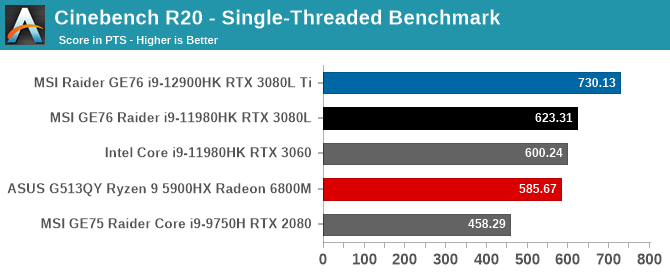
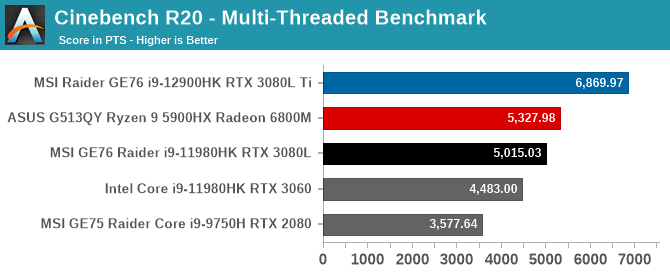
Always a popular benchmark due to its ease of use and ability to set the test to be single-threaded or multi-threaded, Cinebench is more of a pure CPU test since it does not leverage the GPU at all and is not very memory intensive.
Tiger Lake had a small single-threaded performance lead over the latest Ryzen processors, and Alder Lake simply smashes both of them. The single-threaded performance uplift is seriously impressive.
On the multi-threaded side, AMD’s better power efficiency with Ryzen allowed them to pull ahead in the past, but now that Alder Lake features 20 threads compared to 16 in the Ryzen 9 5900HX, the Core i9-12900HK pulls well in front with all threads loaded. This is despite it having only twelve threads of performance cores, so the eight E-Cores are definitely pulling their weight here.
Handbrake

Probably the most popular transcoding tool around, Handbrake has support for software-based transcoding as well has hardware-based with support for AMD’s VCE, NVIDIA’s NVENC and Intel QuickSync. We test by doing a transcode of a 1080p Blu-Ray rip to 720p with the same quality settings for all encoders. For most transcoding, software transcoding tends to yield the best quality, however the specialty hardware can often complete the task in less time.
As a heavily multithreaded task, AMD’s Cezanne platform was our previous champ here, but Alder Lake demolishes the previous results. The new Golden Cove / Gracemont combination offers an almost 30% uptick compared to Tiger Lake in the same chassis. If you peek down to the Hardware transcode graph, you will see that the new Alder Lake platform is actually quicker at this particular test than the QuickSync was on Tiger Lake. Very impressive.
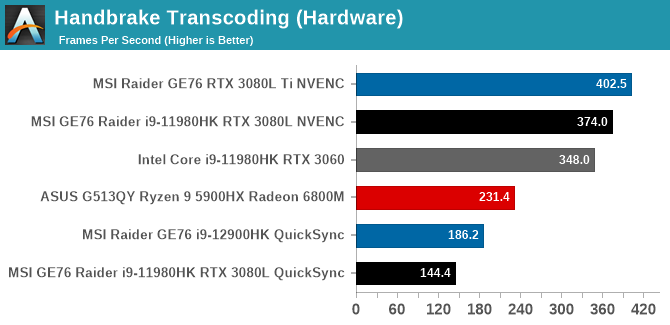
Speaking of hardware transcoding, Intel’s QuickSync does get a bump over Tiger Lake’s implementation, but perhaps unsurprisingly they are smashed by the NVIDIA encoders in the big graphics cards installed in the MSI Raider systems.
7-Zip
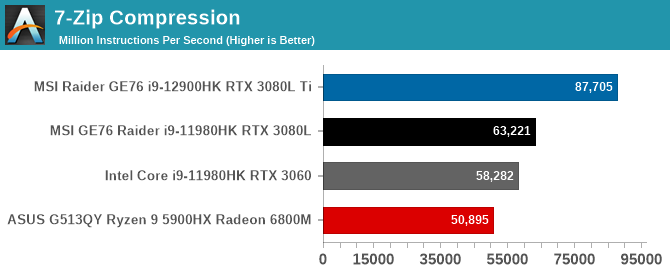
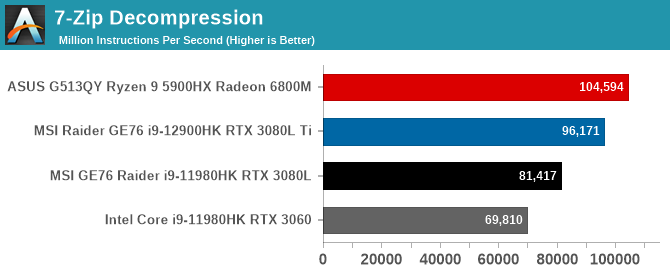
Despite a massive uplift in compression speed in the Core i9-12900HK, Intel isn’t quite able to wrestle the decompression crown away from AMD’s Ryzen 9 5900HX, although it is much, much closer than it was before.
Web Tests
Although web performance is an integral part of most people’s lives now, testing web performance is both testing the CPU performance as well as the browser’s scripting engine. As such, to be as consistent as possible, all web benchmarks are run on the current version of Microsoft Edge, which is based on the Chromium web browser. However, updates to the browser which happen very frequently could impact performance, so any results we have in our database are snapshots from the time that laptop was reviewed. For now, with the decommissioning of several popular browser benchmarks, we are focusing on Speedometer 2.0 from Webkit, and WebXPRT 3 from Principled Technologies. WebXPRT 4 is in preview now, and once it launches, we will take a look at it for future reviews.
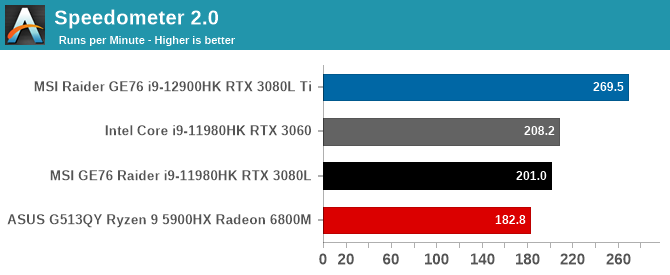
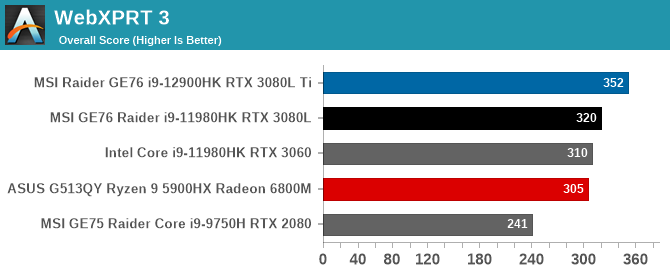
Web performance is often dependent on single-threaded performance, as well as how quickly a processor can ramp up to maximum performance. Both AMD and Intel have made big improvements in how quickly their processors can boost to their maximum frequency, as well as how many steps there are on the way.
With Intel’s hefty increase in single-threaded performance with the Golden Cove CPU architecture it should be no surprise to see them at the top. How far they are in front though is very impressive.
System Performance Summary
Wow is a good word to summarize. Intel’s newest Alder Lake with its new hybrid design, featuring both Golden Cove and Gracemont CPU cores, delivers a substantial increase in performance over their outgoing Tiger Lake platform. With six P-Cores and eight E-Cores, the new Core i9-12900HK offers an impressive twenty threads. With dissimilar performance of the threads, extra legwork was needed to be done to correctly distribute workloads to the right cores, but Intel has done that with their Thread Director system which is integrated into Windows 11.
Intel has squarely thrown the ball back into AMD’s court. Intel now lead in CPU performance by a substantial margin, and Intel’s Iris Xe graphics also delivers more performance than the current Vega GPU in Ryzen 5000. This is a potent combination.


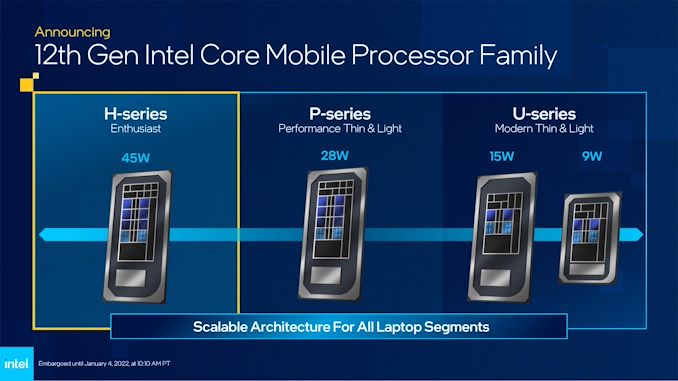








153 Comments
View All Comments
tkSteveFOX - Wednesday, January 26, 2022 - link
Just a note for Brett here, when you do a laptop review thermals, throttling and noise levels are important things to have in the review.Brett Howse - Wednesday, January 26, 2022 - link
This isn't a laptop review. Please check the link to the GE 76 Raider review we did in September.TheinsanegamerN - Friday, January 28, 2022 - link
*reviews laptop CPU**uses laptop*
*this is not a laptop review*
Whew, anandtech quality ladies and gentlemen! I guess that throttling and thermals are not important in CPU tests either? Or would that get in the way of using RAM to exuse the hideous power draw?
corinthos - Wednesday, January 26, 2022 - link
Whole point of a laptop is portability and using unplugged for a considerable amount of the time. That's why you pay a premium. If the best Intel can do is 3.x hours on battery, this is essentially a desktop alternative/replacement, in which case you get even more for your money just buying a desktop.Brett Howse - Wednesday, January 26, 2022 - link
This is literally a desktop replacement. That's actually a product category for notebooks.Spunjji - Thursday, January 27, 2022 - link
I'm sorry you have to keep replying to comments like this...Spunjji - Thursday, January 27, 2022 - link
For me, those "percentage of no load performance" graphs may have been the most interesting. It certainly shows what Alder Lake can offer when it's being used to the fullest. It doesn't represent a use-case that I'd ever put a laptop to, but it will be very interesting for the sort of user for whom 20 threads in a mobile CPU is less a flashy selling point and more a necessity.Otherwise it's looking as I expected - peak performance is significantly better than the ageing Cezanne platform, sustained performance in a slightly more representative platform remains to be seen. Tiger Lake H was ~25% down on Cezanne in terms of performance/watt in multithreaded loads, so there's certainly potential here for Intel to have caught up and maybe even surpassed that.
abufrejoval - Thursday, January 27, 2022 - link
The least impressive statement in this review is this “Perhaps the most impressive result though is Intel’s Thread Director, which provides very impressive system responsiveness even when the system is at 100% CPU load…”, because to me it sounds either like paid content or lack of reflection.Intel is pushing E-cores as a “must have”, because it’s exclusive to their platform, very much like MMX or AVX-512 back then.
But it’s mostly yet another marketing smoke bomb.
I am convinced you could achieve a very similar gain in responsiveness by emulating the 8 E-cores via the 2 P-cores they replace in terms of silicon real-estate on Alder Lake. What you perceive as a hardware benefit is mostly an OS defect in workload management.
What happens here is that long running batch and latency sensitive interactive workloads are being separated and assigned to hardware partitioned processing pools dependent on whether they are running in the “foreground” or “background”. Doing that in the Windows task manager today, is obviously cumbersome, but writing a tool that prohibits the usage of all CPU cores once workloads are switched to background, should be trivial enough. And to my knowledge even cache partitioning has been part of x86 since Broadwell to ensure that busy background batch tasks won’t flush latency sensitive interactive workloads entirely from them.
Yes, E-cores have been proven to squeeze longer run times out of smartphones or more concurrent session support per Watt in certain cloud servers, because they are designed to be more efficient in in terms of instructions per Watt/h at the price of instructions per unit of time.
But those constraints do not apply to a gaming laptop or most desktop computers. Actually, even on ultra-thin laptops CPU core power consumption is becoming a rather insignificant contributor to overall energy spend, outside of some synthetic fringe cases.
Intel fits 8 E-cores into a similar space for 2 P-cores, so the high-end mobile Alder-Lake parts could just be 8 P cores or 32 E cores or any of the other permutations. And quite obviously you would be able to find workloads with an ideal fit for each, just as you’d also find workloads that violate either performance or efficiency targets on them.
Intel promotes a hardware partitioned compromise between E- and P-cores and then interestingly charges an E-core premium on desktop parts, where collective energy savings on remotely managed always-on volume parts might actually provide an ecological benefit. But I can’t help thinking, that a software solution via “E-core emulation” would deliver more flexibility and adjustable performance on most laptops and workstations and prefer 8P+0E over 6P+4E practically everywhere except server parts.
Bik - Thursday, January 27, 2022 - link
Simple thought will prove this correct: a big task that feels like it bogs down the whole system, will no longer be so if you willing to sacrify some cores for background tasks. The scheduler just isnt smart enough to do that today.There's another thing I notice. When it is true that 8-E cores put up more performance than 2-P cores, Intel claims of silicon real-estate between the two being equal may not be correct. Because if they do, we'll surely have all E-cores cpu for heavy multi-thread work loads. But that didnt, and I doubt, will ever happen.
diediealldie - Thursday, January 27, 2022 - link
oh, they will. There's Sierra Forest AP which consists of 128 e-cores. Intel is not making all e-cores yet since launched platforms are kind of mass-market general-purpose ones which need high ST performance along with good MT performance.